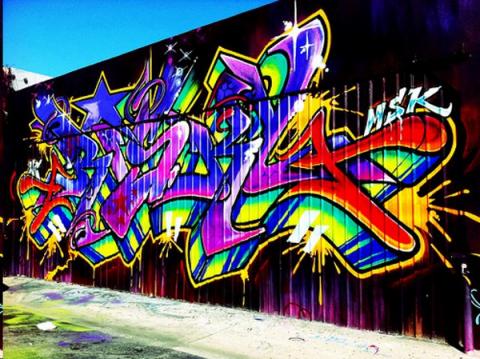How Street Art Went Hollywood

It was the mid-1970’s when Fab 5 Freddy and his crew, “The Fabulous 5,” were spray painting their names across New York City. It was 1979 when he and Lee Quinones were given a gallery in Rome, and it was a year later that he famously painted Warhol-esque Cambell’s Soup cans on the side of a subway car.
Jean-Michel Basquiat, the Brooklyn-born painter who sold a piece for $14.6 million post-mortem started his career as a graffiti artist under the name, “SAMO.” This could be argued as the first modernistic conversion of basic graffiti into pop art, but is there even a significant difference? For more than 25 years, New York has been a hub for graffiti artists, so why is Los Angeles now declaring itself the street art capital of the world and, more importantly, why is no one challenging the claim?
At the base of the argument is a question that has become tirelessly disputed: What is the difference, if any, between graffiti and street art? Some would say the message behind the piece. The subject matter of graffiti is primarily egotistical, in that the artist writes only his name, whether it be in marker or paint. Small, black, nonsensical scribbles on the payphone -- this is considered graffiti. The immense indecipherable colors with arrows and bubble letters on the alley wall, that too, and it’s been around for literally centuries, dating back to ancient Greece.
Street art, however, is a newer concept. It employs more typical artistic imagery with detailed paintings usually touching on politics, comedy, or society itself. But at this point, there is no real difference. It’s all become commercialized.

Ever since London-based artist Banksy started making waves in the art world, the hobby of spray painting pictures on brick walls not only seems to have potential for a career, but a profitable one. Instead of tagging their name on a wall as an act of defiance, many young street artists do so in hopes of one day having their name turn into a brand like Shepard Fairey, who turned his stencil of Andre the Giant into an infamous marking known the world over and developed its moniker to “Obey” into a popular clothing line. For youths to show interest in an art form is a good thing, but whereas once it was used strictly by a defiant subculture, it is now accessed all the wrong reasons.
Street art has in recent years become the subject of books, magazines, television shows, clothing, and the documentary “Exit through the Gift Shop” proved that practically anyone can make a fast buck through its exploitation. Perhaps this is why Los Angeles has the ability to make the claim of being the epicenter of street art. Even though New York invented modern-day tagging and train-writing, and Banksy-style stencils had appeared throughout Paris in the ‘80s (created by artists like Blek le Rat), no city is capable of embracing street art’s grand money-making scheme like Hollywood.
In the modern days of the viral video, fat cats are on the lookout for “the next big thing.” They have their “ears to the streets” so to speak. They went digging for a gold mine and instead struck oil. They found a product that’s been in the business of being “cool” for decades, and the artists themselves produce free advertising by painting over billboards.

In the past year, Los Angeles was host to the “Art in the Streets” exhibit at the Museum of Contemporary Art, a gallery of some of the most prolific street artists of the past 35 years, and opened the doors to Lab Art, which claims to be “the largest street art gallery in the world.” Artwork is sold for six figures, and live painting is frequently showcased at party spots like The Standard Hotel.
Is there viable art in the streets of Los Angeles? A slow drive down Melrose will prove that yes, there is. However, in a world where street art is abundant in any major city, is it still fair to say that an urban sprawl that only truly began to hold stock in the subculture a few years ago is the eye of the storm? No. But street art hit pop-culture car crash and went Hollywood, and if there’s one town willing to embrace a fast-money sellout, it’s, well, Hollywood.
Author Bio:
Adam Chardis is a contributing writer at Highbrow Magazine.
Additional photos: Colorlines; la.streets.blog.org. Photo on main page: Jaebueno.com.
Coming up in Highbrow Magazine: Photographer/Writer Christopher Moraff's photo essay of Chilean street art.





























































































































































































































































































































